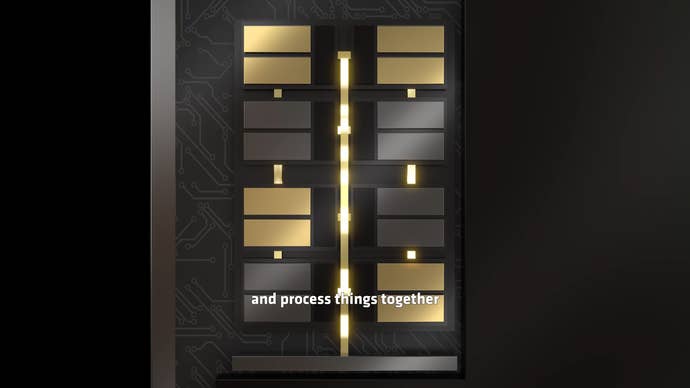Sony and AMD simply introduced three key applied sciences that look more likely to come to the PlayStation 6 and future AMD graphics playing cards, with PS5 system architect Mark Cerny and AMD senior vice chairman Jack Huynh teaming as much as ship the information. The speak is pretty technical, however the three core options – Neural Arrays, Radiance Cores and Common Compression – look set to make a big effect on future AMD-based {hardware}. The principle purpose is dashing up computionally-expensive ray tracing and path tracing in some novel methods, in addition to decreasing the price of the upscaling and denoising methods they depend on.
Let’s begin with Neural Arrays. Briefly, this can be a new association of the handfuls of Compute Models (CUs) that make up a graphics processor like that within the PS5 Professional. Usually every of those CUs work alone on a bite-sized piece of the puzzle, which is smart for many duties, however may be inefficient for upscaling methods like FSR or PSSR. Neural Arrays subsequently hyperlink a number of CUs collectively in a “sensible, environment friendly method”, like a “single, targeted AI engine”.
The profit is that this ought to permit for greater (and subsequently greater high quality) machine studying fashions, with much less overhead and higher scalability. To say it one other method, it signifies that an upscaling algorithm like PSSR should run sooner at a given high quality stage, or accomplish extra in a given time-frame. The identical speed-up additionally applies to denoising algorithms, that are essential for ray-traced or path-traced graphics.
Huynh additionally guarantees that Neural Arrays will permit for brand spanking new options, together with “devoted improvements that convey cinematic rendering to a wholly new stage.”
Radiance Cores are the second new know-how, and so they’re firmly a {hardware} change. Basically, this can be a new devoted {hardware} block in next-generation AMD graphics processors that is “designed for unified mild transport”, ie ray tracing and path tracing. Within the PC area, Nvidia has lengthy held a ray tracing efficiency benefit due to its RT cores, and it appears to be like like lastly AMD is adopting an identical technique.
Simply as different devoted {hardware} we have seen seem in graphics playing cards over time, comparable to those who cope with media encoding or AI processing, Radiance Cores accomplish their given activity sooner than doing the identical factor on extra generic {hardware}. This hastens the intensive work of ray traversal – “digging via advanced knowledge constructions to find the place the thousands and thousands of rays being solid hit the thousands and thousands of triangles within the scene geometry”.
In addition to the speed-up from having devoted {hardware}, this variation additionally unburdens the CPU and the remainder of the GPU – in order that they’ll carry out the issues they’re greatest suited to, comparable to simulation and geometry on the CPU and shading and lighting on the GPU.


The ultimate little bit of tech Sony and AMD introduced is named Common Compression, and fortunately it’s kind of simpler to elucidate. Briefly, it is a system that compresses the whole lot that goes out to GPU reminiscence, somewhat than only a few knowledge sorts like textures, as is at present the case on the PS5 and PS5 Professional. Once more, that is alongside comparable strains to an current Nvidia know-how, on this case Neural Texture Compression.
By including this compression step, efficient GPU reminiscence bandwidth is way greater. Which means frame-rates may enhance in case you’re bandwidth-limited, however extra importantly it permits for higher-quality property and reduces energy consumption too. This system has broad constructive implications, nevertheless it additionally particularly helps make each Neural Arrays and Radiance Cores more practical.
These applied sciences at present exist solely in simulation, based on Cerny, however clearly each events are assured sufficient to element them at this early stage. Huynh additionally mentions that AMD is aiming to convey the applied sciences to builders “throughout each gaming platform”, which might comply with within the firm’s normal method of open-sourcing its graphics improvements.

It is going to be fascinating to see how these applied sciences work after they begin to be realised in actual {hardware}, and given the Undertaking Amethyst partnership to date, it appears cheap to imagine that the 2 corporations will make additional bulletins over the following few years because the tech will get nearer to completion – and when the anticipated PlayStation 6 is formally introduced.
Past the rumoured PlayStation 6, we might additionally see these approaches being utilized in a PlayStation or Home windows-based gaming handheld. Energy consumption and reminiscence bandwidth limitations are key challenges for any cell kind issue, so little doubt the likes of Valve, Asus and Lenovo can be mighty concerned with any vital developments. Valve has famously stated that they are ready for a “generational leap” to justify a Steam Deck 2, and this may simply qualify.
Equally, that is enormous information for followers of AMD desktop graphics playing cards, which have historically provided nice worth to efficiency in rasterised video games and loads of VRAM, however have fallen behind Nvidia options when it comes to RT efficiency and different options. AMD might massively shut the hole right here, and that is an thrilling prospect.
Both method, I am joyful to see Sony and AMD share the fruits of their partnership so brazenly, and it is actually meals for thought in terms of seeing how Sony, AMD and different tech giants need to circumvent the rise in silicon prices that has prevented sooner, cheaper fashions from arriving this console era.















